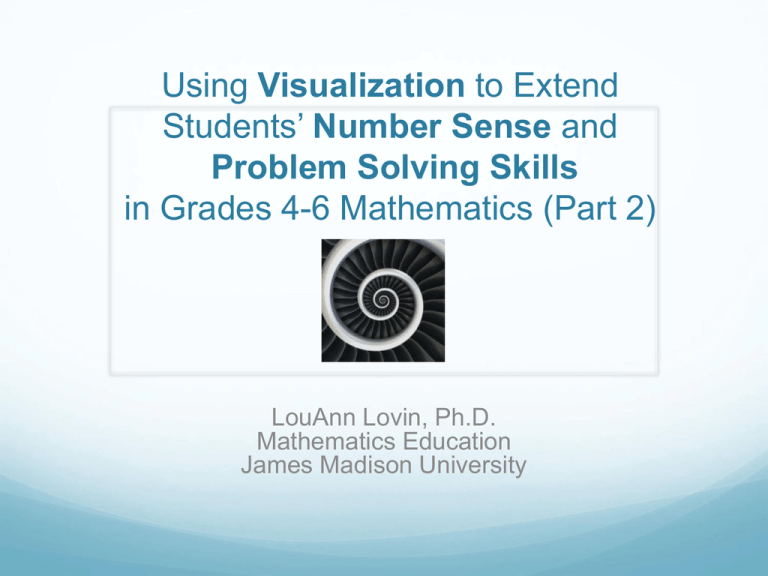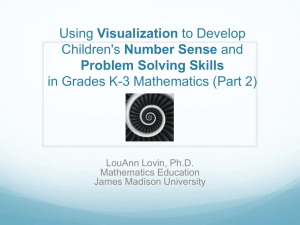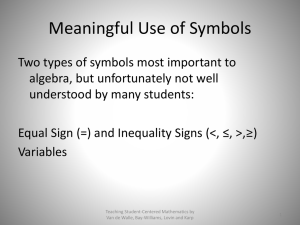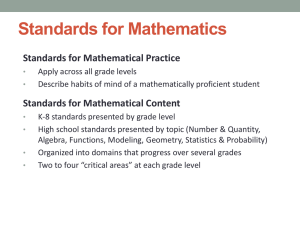Part 2
advertisement

Using Visualization to Extend Students’ Number Sense and Problem Solving Skills in Grades 4-6 Mathematics (Part 2) LouAnn Lovin, Ph.D. Mathematics Education James Madison University Comparing Fractions How do you compare fractions? 2 5 Lovin NESA Spring 2012 5 8 2 Comparing Fractions Comparing Fractions using “size” of parts Which is larger? 3/5 or 2/5? Which is larger? 1/8 or 1/9? Which is larger? 12/17 or 12/19? Lovin NESA Spring 2012 3 Comparing Fractions Comparing Fractions by thinking of benchmark fractions (and size of parts) (0, ½, 1) Which is larger? 2/5 or 5/8? Which is larger? 9/10 or ¾? Lovin NESA Spring 2012 4 Comparing Fractions 1. Same-size parts 3 8 5 8 Common Denominator 2. Same number of parts but different kind of parts 5 5 Common Numerator 7 8 3. More or less than one-half or one whole 4. Distance from one-half or one whole Lovin NESA Spring 2012 9 10 2 5 5 8 3 4 5 A large candy bar is section off: If Pat gets ⅓ of what is left, then Pat gets ____ of the candy bar. So, ⅓ of ¾ is _____. Lovin NESA Spring 2012 6 Draw a (proportional) diagram to solve the problem. (Label your diagram.) There was ¾ of a pie left in the refrigerator. John ate ⅔ of what was left. How much pie did he eat? What is the whole (the unit) for each given fraction and for the answer? Lovin NESA Spring 2012 7 Draw a (proportional) diagram to solve the problem. (Label your diagram.) Mrs. Green bought 3/5 lb of sugar. She used 2/3 of it to make a cake. How much sugar did she use? Mrs. Green bought 3/5 lb of sugar. She used ¾ of it to make a cake. How much sugar did she use? Lovin NESA Spring 2012 8 Draw a (proportional) diagram to solve the problem. (Label your diagram.) Mrs. Smith bought 5/6 lb of hamburger. She cooked 2/3 of it. How much hamburger did she cook? Can you see 10 = 5 in your diagram? 18 9 Lovin NESA Spring 2012 9 Act these problems out. Pay attention to your actions. Mark has 12 apples. He wants to share them equally among his 4 friends. How many apples will each friend receive? Mark has 12 apples. He put them into bags containing 4 apples each. How many bags did Mark use? What is known in each situation? What are you trying to find in each situation? Lovin NESA Spring 2012 10 What is known in each problem? (What is known determines the action used by the student.) Mark has 12 apples. He put them into bags containing 4 apples each. How many bags did Mark use? Measurement (know # in each group) Want to find how many groups Types ofHe word problem handout Mark has 12 apples. wants to share them equally among his 4 friends. How many apples will each friend receive? Partitive or Sharing (know # of groups) Want to find how many is in each group Lovin NESA Spring 2012 11 Fraction Division Draw a (proportional) diagram to solve the problem. (Label your diagram.) 4 boys shared 2/3 of a pie equally. What fraction of the pie did each boy receive? A string of length 4/5 m is cut into 2 equal pieces. What is the length of each piece? Sara poured 2/5 pint of fruit juice equally into 4 cups. How much fruit juice was there in each cup? Lovin NESA Spring 2012 12 I have 1 yd of ribbon and it takes ⅕ yd of ribbon to make a bow. How many bows can I make? 1 yd ⅕ yd 1÷⅕ Lovin NESA Spring 2012 (How many ⅕s are in 1?) 13 I have 1 yd of ribbon and it takes 3/5 yd of ribbon to make a bow. How many bows can I make? 1÷⅗ Lovin NESA Spring 2012 (How many 3/5s are in 1?) 14 A recipe calls for ½ of a cup of sugar. You have ¾ of a cup of sugar. How many recipes can you make (assuming you have the other ingredients on hand)? How many ½s are in ¾? Lovin NESA Spring 2012 15 Draw a (proportional) diagram to solve the problem. (Label your diagram.) Kathleen had 3/4 of a gallon of milk. She gave each of her cats 1/12 of a gallon to drink. How many cats got milk? Lovin NESA Spring 2012 16 Repeating Decimals Why do fractions like 1/3, 1/6, 1/7, and 1/9 repeat? Lovin NESA Spring 2012 17 Base Ten uses Powers of Ten 1 . 1 10 100 10 102 101 100 . 10-1 1 1000 1 100 10-2 0.1 10-3 0.01 0.001 Lovin NESA Spring 2012 18 Repeating Decimals Why do fractions like 1/3, 1/6, 1/7, and 1/9 repeat? Shade ½ of 1. Shade ¼ of 1. Shade 1/5 of 1. Shade 1/8 of 1. Shade 1/3 of 1. Lovin NESA Spring 2012 19 Take a minute and write down two things you are thinking about from this afternoon’s session. Share with a neighbor. Lovin NESA Spring 2012 20 Take Aways Emphasis is on helping students think about quantities and their relationships to each other (developing number sense). Visualization strategies can make significant ideas explicit (color coding, highlighting significant ideas in students’ work) Lovin NESA Spring 2012 21 Not everyone sees what you may see. An old man’s face or two lovers kissing? Cat or mouse? So we must listen to our students and make sense of the sense they are making of the mathematics. Lovin NESA Spring 2012 22 References Diesmann, C., & English, L. (2001). Promoting the use of diagrams as tools for thinking. In A. Cuoco & F. Curcio (Eds.), The Roles of Representation in School Mathematics, pp. 77-89. Reston, VA: NCTM. Dolk, M. & Fosnot, C. (2005). Fostering Children’s Mathematical Development CD. Portsmouth, NH: Heinneman. Hersch, S., Fosnot, C., & Cameron, A. (2005). Fostering Children’s Mathematical Development: Landscape of Learning Grades 35. Portsmouth, NH: Heinneman. Fosnot, C. & Dolk, M. (2001). Young Mathematicians at Work: Constructing Multiplication and Division. Portsmouth, NH: Heinneman. Fosnot, C. & Dolk, M. (2002). Young Mathematicians at Work: Constructing Fractions, Decimals, and Percents. Portsmouth, NH: Heinneman. Gersten, R. & Clarke, B. (2007). Research Brief: Effective Strategies for Teaching Students with Difficulties in Mathematics. NCTM: Reston, VA. Ministry of Education Singapore. (2009). The Singapore Model Method. Panpac Education: Singapore. NCTM (2000). Principles and Standards of School Mathematics. NCTM: Reston, VA. Parrish, S. (2010). Number Talks: Helping Children Build Mental Math and Computation Strategies. Math Solutions: Sausalito, CA. VandeWalle, J. & Lovin, L. (2005). Teaching Student-Centered Mathematics: Grades 3-5. Boston: Pearson. Lovin NESA Spring 2012 23











